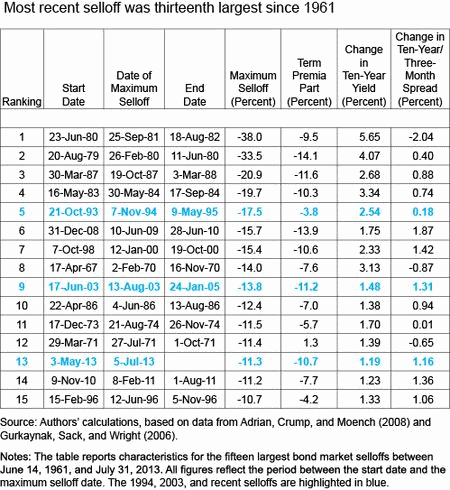Is the recent change in long-term Treasury yields the result of investors optimism about higher short-term rates down the road, or are they demanding more return on their long-term investment gamble? Two vice presidents in the Federal Reserve Bank of New York,s Research and Statistics Group looked at that question in a recent entry on the Bank's Liberty Street Economics page.
Tobias Adrian and Michael Fleming said that recent long-term yields have risen sharply, going from 1.63 percent on May 2 to 2.74 percent on July 5, the highest level in exactly two years. As yields and prices move inversely, the recent sharp rise in yields has resulted in losses to the owners of Treasury securities which they put at -9.8 percent over a 42 days period The two point out that, "The decline is large by historical standards, but somewhat smaller than that observed in two-month windows in 1994 (-12.6 percent), 2003 (-14.4 percent), and other recent periods (for example, -10.3 percent in late 2010)."
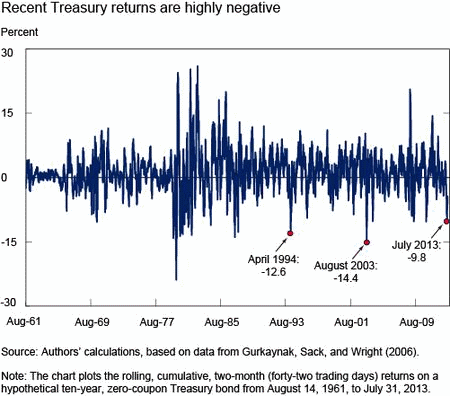
The authors defined a sell-off by cumulating returns for a hypothetical ten-year zero-coupon Treasury security from June 1962, identifying each time those cumulating returns reached a maximum for the period-to-date. On a second pass through the data they cumulated returns from the maximum-to-date and whenever they dropped 1.2 percent (two standard deviations of daily returns) below the maximum they marked that as the start of a sell-off. When the return later passed the two standard deviation threshold on the way back up the sell-off was considered to have ended.
In this manner the authors identified b in which the cumulative returns for the bond dropped below -5 percent with an average for the 31 occurrences being -11.9 percent and the worst (for an episode from June 1980 to August 1982) resulting in a 38.0 percent loss. The average length of the 31 sell-offs was 303 calendar days (not counting the current sell-off for which no end date is known); the minimum was 16 days (June/July 1985) and the maximum 1,309 days (April 1967 to November 1970).
The authors plotted the 31 sell-offs and found the recent one was comparable though somewhat smaller than two others in 1994 and 2003. Looking more closely at those two comparables, each behaved similarly in the first month to the current one but at the end of that period negative returns continued for the 2003 and 2013 episodes but remained flat for sometime in 1994 before resuming a downward trajectory, bottoming out about a year after the sell-off started (but not during the plotted period.)
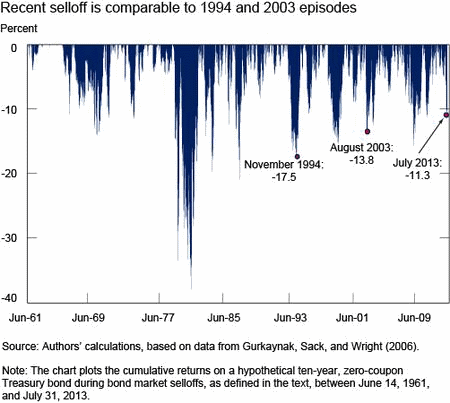
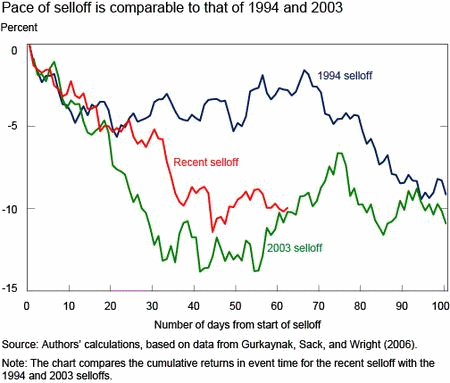
The current sell-off is fairly steep by historical standards. Cumulative returns are between the median and the fifth percentile for all sell-offs at a roughly comparable stage and as of July 5 were just above the fifth percentile. Over the remainder of the month yields increased modestly and cumulative returns did as well.
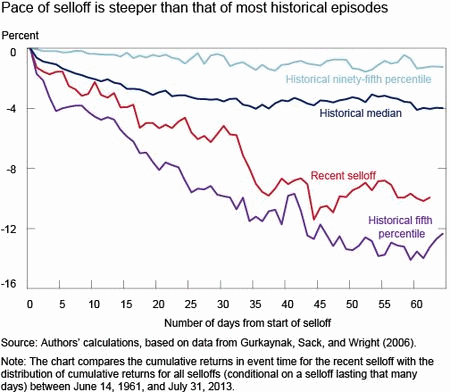
Returning to the original question of what explains the sell-off; whether investors are expecting higher short-term rates in the future than they did just a short time ago or are demanding greater compensation for their long-term risk. The latter reason for the rise might be explained by an increase in the term premium so the authors used the ten-year, zero-coupon term premium estimates and for each sell-off cumulated the returns that could be explained by changes in the term premium alone.
And indeed, this is what they found. The cumulative returns based on the term premium along (the red line in the chart below) are almost as large as the cumulative returns based on the raw yields (in blue). "The finding that the sell-off can be attributed nearly entirely to movements in the term premium is in stark contrast to decompositions of yield movements in the tightening cycles of 1994 and 2004, when yield movements were nearly entirely due to changes in the future path of policy, as explained in a recent blog post by Adrian, Crump, and Moench," the authors said.
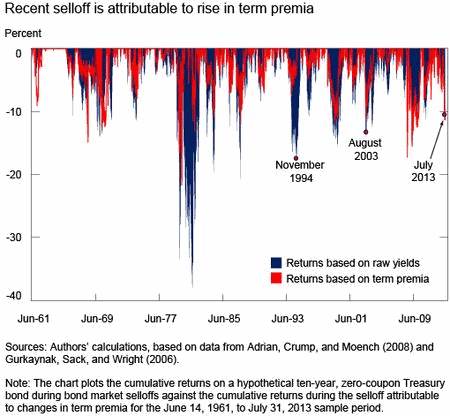
Finally Adrian and Fleming presented a table with the
attributes of the fifteen largest sell-offs since 1961, highlighting
the current one, ranked 13th and and the two comparables of 1994 and
2003 discussed above, ranked fifth and ninth respectively. The
table shows the change in the ten-year, zero-coupon yield and the
spread between the ten-year and three-month yields at the start of
each sell-off and at the maximum sell-off date. In both the current
episode and the one in 2003 the yield spread moved almost as much as
the ten-year yield itself (that is the three-month yield rose
little), explaining the importance of the term premium in those
cases. In the 1994 episode the three-month yield increased almost as
much as the ten-year, minimizing the spread and explaining the
important of short term rate expectations in that episode.
